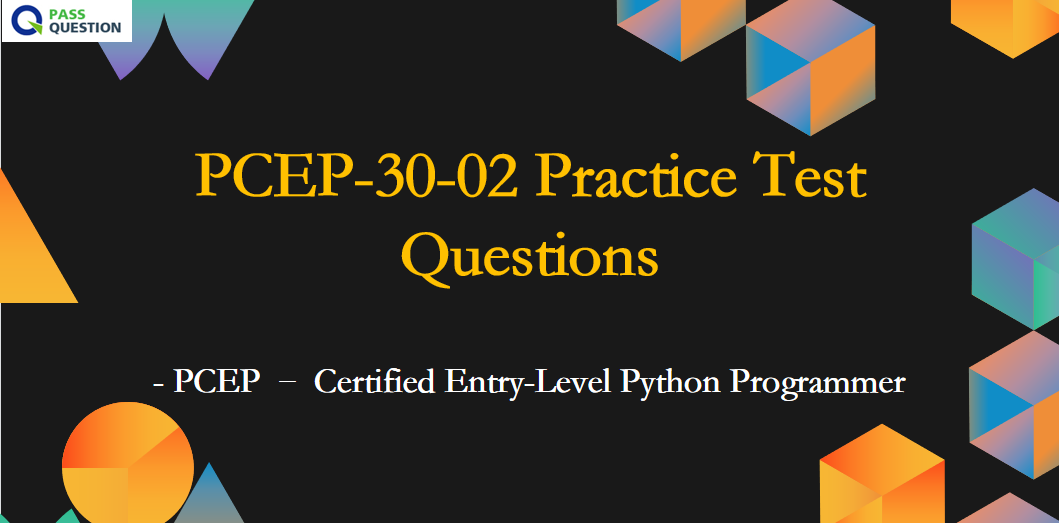PCEP-30-02 Practice Test Questions - PCEP – Certified Entry-Level Python Programmer
If you are interested in learning Python programming and getting certified by the Python Institute, you may have heard of the PCEP-30-02 exam. PCEP-30-02 stands for PCEP – Certified Entry-Level Python Programmer, and it is a certification test that validates your basic knowledge and skills in Python programming. To prepare for the PCEP-30-02 exam, PassQuestion provides the latest PCEP-30-02 Practice Test Questions which are written by experts who have rich experience in Python programming and certification. PassQuestion PCEP-30-02 Practice Test Questions cover all the topics and objectives of the real exam, and they are formatted in the same way as the real exam. By using PassQuestion PCEP-30-02 Practice Test Questions, you can not only test your knowledge and skills but also familiarize yourself with the exam format and difficulty. It can help you boost your confidence and improve your chances of passing the exam.

PCEP – Certified Entry-Level Python Programmer certification (Exam PCEP-30-02)
PCEP – Certified Entry-Level Python Programmer certification (Exam PCEP-30-02) is a professional credential that measures the candidate's ability to accomplish coding tasks related to the essentials of programming in the Python language. A test candidate should demonstrate sufficient knowledge of the universal concepts of computer programming, the syntax and semantics of the Python language, as well as the skills in resolving typical implementation challenges with the help of the Python Standard Library.
Becoming PCEP certified ensures that the individual is acquainted with the most essential means provided by Python 3 to enable them to start their own studies at an intermediate level, and to continue their professional development. PCEP certification is an interim step to the PCAP certification, and the starting point to launch a career in software development, Python programming, and related technologies. Becoming PCEP certified helps certification holders stand out from other candidates, get a foot in the door with an employer, and land a junior-level job in the IT sector and anywhere the basic knowledge of Python is an asset.
Exam Details
Exam name: PCEP – Certified Entry-Level Python Programmer
Exam Code & Current Exam Versions: PCEP-30-02 (Status: Active)
Exam Duration: PCEP-30-02 – Exam: 40 minutes, NDA/Tutorial: 5 minutes
Number of Questions: 30
Format: Single- and multiple-select questions, drag & drop, gap fill, sort, code fill, code insertion | Python 3.x
Passing Score: 70%
Languages: English, Spanish
Cost: USD 59 (Exam: Single-Shot)
Exam Sections
Section1: Computer Programming and Python Fundamentals (18%)
Section2: Control Flow – Conditional Blocks and Loops (29%)
Section3: Data Collections – Tuples, Dictionaries, Lists, and Strings (25%)
Section4: Functions and Exceptions (28%)
View Online PCEP – Certified Entry-Level Python Programmer PCEP-30-02 Free Questions
1. What will be the output after the user enters 0?
user_input = input('What is your value? ')
print(1/user_input)
A. number 0 shown to the console
B. TypeError raised
C. ZeroDivisionError raised
D. ValueError raised
Answer: B
2. What is true about the following code snippet?
list1 = [1, 2, 3]
list2 = list1[:]
A. list2 and list1 will point to the same list in the memory
B. list2 and list1 will point to two different lists in the memory
C. The syntax list1[:] is incorrect and Python will show an error because you need to provide at least one index in the square brackets
D. It is impossible to predict upfront if the two variables will point to the same list or not.
Answer: B
3. What will be the output of the following code?
if 2 == 2.0:
print('yes')
else:
print('no')
A. no
B. Python will show an error
C. Nothing will be printed to the output
D. yes
Answer: D
4. What is CPython?
A. It' a programming language that is a superset of the C language,
B. designed to produce Python-like performance with code written in C
C. It' a programming language that is a superset of the Python,
D. designed to produce C-like performance with code written in Python
E. It's a default, reference implementation of the C language, written in Python
F. It's a default, reference implementation of the Python language, written in C
Answer: F
5. Strings in Python are delimited with:
A. backslashes (i.e., \)
B. double quotes (i.e., ") or single quotes (i.e., ')
C. asterisks (i.e., *)
D. dollar symbol (i.e., $)
Answer: B
6. What are the four fundamental elements that make a language?
A. An alphabet, phonetics, phonology, and semantics
B. An alphabet, a lexis, phonetics, and semantics
C. An alphabet, morphology, phonetics, and semantics
D. An alphabet, a lexis, a syntax, and semantics
Answer: D
- TOP 50 Exam Questions
-
Exam
All copyrights reserved 2025 PassQuestion NETWORK CO.,LIMITED. All Rights Reserved.

